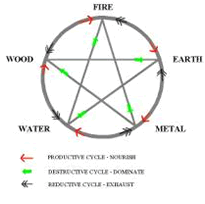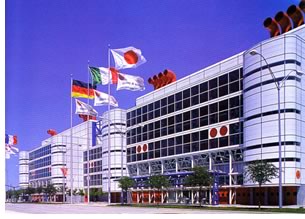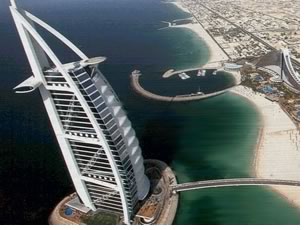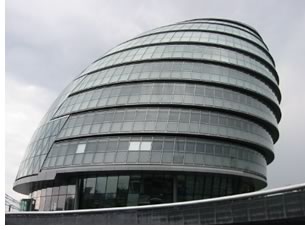

2/2006

by Russell Boniface
Associate Editor
Feng Shui, pronounced “fung shway,” is the Chinese art and science of constructing environments that create balance and harmony. Architects are taking more interest in the quirky centuries-old Feng Shui philosophy since it became a trendy home décor technique. Now, office, hotel, bank, and retail clients are coming to architects requesting Feng Shui design.
 The five elements
The five elements
Homeowners following Feng Shui adhere to some irregular design methods
as laid out by the ancient art, using its principles to decide interior
and exterior shapes and colors, landscape, and even the orientation
and location of their house.
The basic belief of Feng Shui, which translates as “wind” and “water,” is to keep positive energy flowing. This energy is called ch’i. It is meant to meander, like a stream. Anything blocking or “rushing” the energy, like high shrubs, sharp corner angles, or a straight walkway, is discouraged. But how can Feng Shui apply to corporate architecture?
C.C. Lee, AIA, president of STOA International Architects and founder of the Feng Shui Institute of Houston, believes architecture, in essence, is Feng Shui. “The only difference between the two is that Feng Shui deals with invisible dimensions,” explains Lee. “Architecture should be the easiest profession to understand Feng Shui. We are actually already doing 80 percent of what Feng Shui talks about because Feng Shui is very close to modern architecture. So now the issue is how we can make architects realize that extra 20 percent.”
 In
Feng Shui, everything boils down to the five elements that the Chinese
believe compose the universe: metal, water, wood, fire, and earth. These
elements are considered the five states of energy intensity. According
to the belief, everyone should focus on at least one designated “element” to
dictate the energy flow of their surroundings. To design shapes, orientation,
and colors for a Feng Shui client, the architect needs to find what element,
or elements, will be the focus. This information will come from “the
master”—or, in the case of architecture, the building’s
primary tenant.
In
Feng Shui, everything boils down to the five elements that the Chinese
believe compose the universe: metal, water, wood, fire, and earth. These
elements are considered the five states of energy intensity. According
to the belief, everyone should focus on at least one designated “element” to
dictate the energy flow of their surroundings. To design shapes, orientation,
and colors for a Feng Shui client, the architect needs to find what element,
or elements, will be the focus. This information will come from “the
master”—or, in the case of architecture, the building’s
primary tenant.
“In Feng Shui, the master is the key,” says Lee. “In residential Feng Shui, the homeowner is the master. For a commercial building, however, the major tenant residing in the building is the master—it could be the client if the client will reside in the building, but if the client is not going to reside in the building, the architect will need to know what company will be the major tenant. Then, find out the energy pattern of that company’s president, because that person is the master.”
The shape, color, and orientation of the client/primary tenant’s energy pattern all depend on which one of the five elements that person wants to focus on. First, the breakdown:
 Water focuses on career; it connotes
flow, rest, wealth, and spark
Water focuses on career; it connotes
flow, rest, wealth, and spark- Earth focuses on health; it connotes a solid foundation and productivity
- Wood focuses on stability and family; it connotes growth, steadiness, and flexibility
- Metal focuses on creativity/children; it connotes wealth, power, and firmness
- Fire focuses on fame and reputation; it connotes soaring and attention-getting (and “hot,” of course).
Next, match the element with its assigned shapes, colors, and orientation:
- Water—irregular/wavy shapes; blues, black, dark gray, purple, lavender; north
- Earth—square; yellow, browns, tan, beige, dark terra cotta; southwest, center, and northeast
- Wood—rectangular, columnar; green; east and southeast
- Metal—round, oval, arched; white, gold, silver, brass, copper, chrome, bronze, tin, pewter, light gray; west and northwest
- Fire—triangular, diamond, pyramids, flames; red, orange, medium to light terra cotta, pink, salmon, burgundy; south.
Bingo. You’re a Feng Shui architect.
 “For instance, if the primary tenant is a metal person, go with
a round building,” says Lee. “And for a fire person, triangular
is good. You can also combine elements. If you have an earth person,
who normally would favor a rectangular energy, a triangle can be good
too because fire energy can enhance earth energy. So, if architects can
understand the five energies and the relationships among them, then they
can pick up the Feng Shui concept, and it will be easier for them to
consider issues like orientation and prevailing wind direction, especially
since we are already trained to do that.”
“For instance, if the primary tenant is a metal person, go with
a round building,” says Lee. “And for a fire person, triangular
is good. You can also combine elements. If you have an earth person,
who normally would favor a rectangular energy, a triangle can be good
too because fire energy can enhance earth energy. So, if architects can
understand the five energies and the relationships among them, then they
can pick up the Feng Shui concept, and it will be easier for them to
consider issues like orientation and prevailing wind direction, especially
since we are already trained to do that.”
But it is important in Feng Shui that the elements be kept in balance. Says Lee, “Feng-Shui considers everything interacting and interconnected.”
Balancing act of energy
Once shape and color are determined, the energy elements are then balanced
internally using architectural, interior, and landscape design. Therefore,
focus on cement and concrete for the earth person; glass for the water
person; anything wood or metal for the wood person and metal person,
respectively; and a lot of lighting for the fire person.
 Color,
however, is usually the overriding factor when determining the element.
For example, for a fire person, you can take concrete—even
though that’s geared for an earth person—and paint it red,
thus turning it into a fire element for the fire person. This of course
applies to walls, floors, furniture, etc. Landscape design can be anything
that doesn’t block the energy from going inside, including low
and open gardens, sculptures, or rock gardens; a curved walkway to “meander” the
energy, as opposed to a straight walkway that will “rush” the
energy; and a water fountain because water represents careers, wealth,
and spark, as well as—the belief is—that water can cleanse
the air quality. All design uses the energy pattern of the master (the
client/primary tenant) as the guideline. Then, according to Lee, it’s
just about logic.
Color,
however, is usually the overriding factor when determining the element.
For example, for a fire person, you can take concrete—even
though that’s geared for an earth person—and paint it red,
thus turning it into a fire element for the fire person. This of course
applies to walls, floors, furniture, etc. Landscape design can be anything
that doesn’t block the energy from going inside, including low
and open gardens, sculptures, or rock gardens; a curved walkway to “meander” the
energy, as opposed to a straight walkway that will “rush” the
energy; and a water fountain because water represents careers, wealth,
and spark, as well as—the belief is—that water can cleanse
the air quality. All design uses the energy pattern of the master (the
client/primary tenant) as the guideline. Then, according to Lee, it’s
just about logic.
“Feng Shui is not magic,” notes Lee. “It’s about how you arrange your furniture and building to take advantage of surrounding energies to enhance your own energy. The Chinese 5,000 years ago believed this generates better balance, harmony, and luck for people.”
 Go with the flow
Go with the flow
Other keys to consider: symmetry achieves balance; T-shapes are bad because
the energy is too strong and can harm the inhabitants; sharp corner
angles force the energy away; front entrances should showcase bright
light to demonstrate prosperity; the higher the ceiling, the less energy
there is, so a cozier office space will better contain energy; the
main entrance shouldn’t be aligned with any secondary entrances
or large windows so as to keep prosperity from flowing out of the building;
live evergreen plants in the office symbolize prosperity; a building
should not be built at the end of a dead-end road—the energy
doesn’t go anywhere there; the building should not have long,
narrow corridors, maze-like hallways, or steep stairways—this
will just rush the energy; columns should have round corners, not sharp,
so that the corner does not create harmful energy; it’s good
to have a variety of lights and lighting, including in hallways and
stairways (be cautious of too much intense lighting, though); and avoid
a design that could cause a person to lose their focus, such as an
entire wall of glass.
 A very prominent example of corporate Feng Shui is Disneyland Hong Kong.
Perhaps the most prominent developer associated with Feng Shui is Donald
Trump, reputed to have a team of Feng Shui practitioners. Companies such
as Citibank, Chase Asia, the Morgan Bank, Rothschild’s, and the
Wall Street Journal have also consulted with Feng Shui practitioners.
As for specific buildings, the most well-known might be the Sydney Opera
House in Australia; the tallest Feng Shui building is The Kingdom Centre
Riyadh in Saudi Arabia; the most unique Feng Shui office building could
be London’s City Hall, which looks like a pile of coins; The Burj
al Arab—The Arabian Tower—in Dubai, United Arab Emirates,
might be the most interesting example of wind and water (as well as the
most extravagant Feng Shui hotel) as it resembles a sail stemming from
a luxury yacht, readying to set sail.
A very prominent example of corporate Feng Shui is Disneyland Hong Kong.
Perhaps the most prominent developer associated with Feng Shui is Donald
Trump, reputed to have a team of Feng Shui practitioners. Companies such
as Citibank, Chase Asia, the Morgan Bank, Rothschild’s, and the
Wall Street Journal have also consulted with Feng Shui practitioners.
As for specific buildings, the most well-known might be the Sydney Opera
House in Australia; the tallest Feng Shui building is The Kingdom Centre
Riyadh in Saudi Arabia; the most unique Feng Shui office building could
be London’s City Hall, which looks like a pile of coins; The Burj
al Arab—The Arabian Tower—in Dubai, United Arab Emirates,
might be the most interesting example of wind and water (as well as the
most extravagant Feng Shui hotel) as it resembles a sail stemming from
a luxury yacht, readying to set sail.
An example of a Feng Shui airport is the Kansai Airport Terminal in Osaka,
Japan, which is built on a man-made island with giant curved-ceiling
terminals.
May Feng Shui be with you
Lee predicts that Feng Shui will continue catching on with Western architects,
especially now that it is being requested more by prospective clients. “The
architecture profession is the least informed on Feng Shui. The real
estate people were the first to adapt to this kind of trend, then interior
designers. We are the last ones. The typical Western architect is not
familiar with this kind of concept. Now, we are becoming more aware.
The fundamental aspect for architects to remember is to design spaces
that will allow positive energy to flow smoothly.”
Copyright 2006 The American Institute of Architects.
All rights reserved. Home Page ![]()
![]()
Photos courtesy of the Feng Shui Institute.
C.C. Lee will lead a session on feng shui at the Pacific Crossings conference,
co-sponsored by the AIA Committee on Design, AIA Northwest Pacific region,
AIA Hong Kong, and the AIA International Committee, in Hong Kong and
Shanghai, October 16–22. Visit the COD Web site to see the preliminary
program. ![]()
![]()